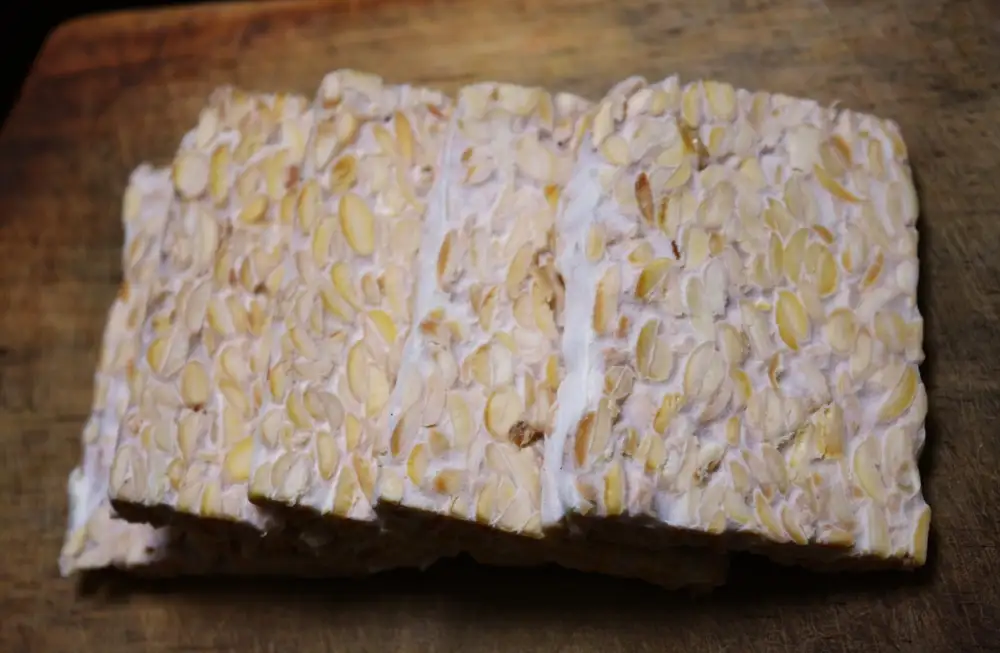Unleash Your Inner Chef: Mastering the Art of Making Tempeh - A Traditional Indonesian Soy Product

- Health Benefits of Tempeh: A Nutritious and Protein-Rich Food
- Step-by-Step Guide on How to Make Tempeh at Home
- Gather the Ingredients for Tempeh Making
- Soaking and Cooking the Soybeans
- Inoculating the Cooked Soybeans with Tempeh Starter Culture
- Incubating the Soybeans to Ferment into Tempeh
- Storing and Using Homemade Tempeh
- Tempeh Variations and Recipe Ideas
- Crispy Tempeh Fries: A Delicious and Healthy Snack
- Tempeh Stir-Fry: A Quick and Flavorful Weeknight Meal
- Tempeh Burger: A Plant-Based Alternative to Meat Patties
- Tips and Tricks for Perfecting Your Tempeh-Making Skills
Tempeh, a traditional Indonesian soy product, has been gaining popularity worldwide for its unique taste and nutritional benefits. Made from fermented soybeans, tempeh is a versatile ingredient that can be used in various dishes. Its nutty flavor and firm texture make it a favorite among vegans and vegetarians as a meat substitute. In this article, we will explore the health benefits of tempeh, learn how to make it at home, discover delicious recipe ideas, and share tips for perfecting your tempeh-making skills. Get ready to unleash your inner chef and embark on a culinary adventure with tempeh!
Health Benefits of Tempeh: A Nutritious and Protein-Rich Food
Tempeh is not only a delicious and versatile ingredient, but it also offers numerous health benefits. As a fermented soy product, tempeh is packed with nutrients and is an excellent source of protein. It contains all the essential amino acids, making it a complete protein for vegetarians and vegans. Additionally, tempeh is rich in fiber, which aids digestion and promotes a healthy gut. It is also a good source of vitamins and minerals, including iron, calcium, and magnesium. Incorporating tempeh into your diet can help support muscle growth, improve bone health, and boost overall immunity.
Step-by-Step Guide on How to Make Tempeh at Home
1. Gather the Ingredients for Tempeh Making: You will need soybeans, water, and a tempeh starter culture.
2. Soaking and Cooking the Soybeans: Soak the soybeans overnight, then cook them until they are soft and easily mashed.
3. Inoculating the Cooked Soybeans with Tempeh Starter Culture: Mix the cooked soybeans with the tempeh starter culture, ensuring that all the beans are coated.
4. Incubating the Soybeans to Ferment into Tempeh: Place the inoculated soybeans in a container and cover it with a clean cloth. Keep it in a warm place for 24-48 hours to allow fermentation.
5. Storing and Using Homemade Tempeh: Once fermented, store your homemade tempeh in an airtight container in the refrigerator. It can be used in various recipes or frozen for later use.
Remember to follow proper hygiene practices throughout the process to ensure food safety. Enjoy your homemade tempeh!
Gather the Ingredients for Tempeh Making
To make tempeh at home, you will need a few key ingredients. The main ingredient is soybeans, which can be easily found in most grocery stores or online. You will also need a tempeh starter culture, which contains the beneficial mold spores that help ferment the soybeans into tempeh. This can be purchased from specialty stores or online. Additionally, you will need water for soaking and cooking the soybeans, as well as a clean cloth or plastic bag for incubating the tempeh. Optional ingredients include vinegar for adjusting the pH level of the soybeans and adding flavor, and spices or herbs for seasoning the tempeh. With these ingredients on hand, you're ready to start making your own delicious homemade tempeh!
Soaking and Cooking the Soybeans
The first step in making tempeh is to soak the soybeans. Place the soybeans in a large bowl and cover them with water. Let them soak for at least 8 hours or overnight. This helps to soften the beans and remove any impurities.
After soaking, drain the soybeans and transfer them to a pot. Add enough water to cover the beans and bring it to a boil. Reduce the heat and let it simmer for about 1 hour or until the beans are tender.
Cooking the soybeans is essential as it makes them more digestible and allows for better fermentation later on. Once cooked, drain the beans and let them cool completely before proceeding to the next step of making tempeh.
Inoculating the Cooked Soybeans with Tempeh Starter Culture
Inoculating the Cooked Soybeans with Tempeh Starter Culture is a crucial step in the tempeh-making process. Once the soybeans have been cooked and cooled, it's time to introduce the tempeh starter culture. This culture contains Rhizopus oligosporus, a type of mold that helps ferment the soybeans and transform them into tempeh.
To inoculate the soybeans, sprinkle the tempeh starter culture evenly over the beans. The amount of starter culture needed depends on the quantity of soybeans being used, so follow the instructions provided with your specific starter culture.
After sprinkling the starter culture, mix it gently into the soybeans using clean hands or utensils. Make sure all the beans are coated with the starter culture to ensure even fermentation.
Once mixed, transfer the inoculated soybeans to a container or plastic bag suitable for fermentation. It's important to create an environment that is warm and allows air circulation for proper fermentation. You can use a special tempeh incubator or simply place the container in a warm spot in your kitchen.
Covering the container with a clean cloth will protect it from dust while still allowing air circulation. Avoid sealing it completely as oxygen is necessary for fermentation.
Now, let nature do its work! Leave the inoculated soybeans undisturbed for about 24-48 hours at a temperature between 85°F (29°C) and 90°F (32°C). During this time, you'll notice white mycelium forming around each bean. This is a sign that fermentation is taking place and tempeh is being created.
Remember to check on your tempeh periodically during fermentation to ensure everything is progressing well. If you notice any unusual smells or colors, discard it as it may indicate spoilage.
Once fully fermented, your homemade tempeh is ready to be used in various dishes or stored for later use. The next section will explore some delicious tempeh variations and recipe ideas to inspire your culinary adventures.
Incubating the Soybeans to Ferment into Tempeh
After inoculating the soybeans with the tempeh starter culture, it's time to incubate them to allow fermentation to take place. This step is crucial as it transforms the soybeans into tempeh, giving it its unique texture and flavor.
To incubate the soybeans, you will need a warm and humid environment. The ideal temperature for fermentation is around 86°F (30°C). You can achieve this by using a food dehydrator, an oven with a low heat setting, or even a warm spot in your kitchen.
Place the inoculated soybeans on a tray or in a container lined with banana leaves or parchment paper. Make sure they are spread out evenly to allow air circulation. Cover them loosely with another piece of banana leaf or parchment paper to retain moisture.
Now, it's time to let nature do its magic. Allow the soybeans to ferment for about 24-48 hours. During this time, you may notice white mycelium forming on the surface of the beans. This is completely normal and indicates that fermentation is taking place.
Check on your tempeh periodically to ensure that it doesn't become too dry or develop any off flavors. If needed, lightly mist it with water to maintain humidity.
Once the fermentation process is complete, you'll have beautifully fermented tempeh ready for cooking! The texture should be firm and compact with a nutty aroma.
Carefully remove the tempeh from the incubation area and store it in an airtight container in the refrigerator. Homemade tempeh can last up to two weeks when properly stored.
Now that you've successfully incubated your soybeans into tempeh, you're ready to explore its endless culinary possibilities! From crispy fries to flavorful stir-fries and even plant-based burgers, homemade tempeh will add depth and nutrition to your meals. So go ahead and unleash your inner chef with this traditional Indonesian soy product!
Storing and Using Homemade Tempeh
Once your homemade tempeh is fully fermented, it's important to store it properly to maintain its freshness and flavor. After removing the tempeh from the incubator, let it cool completely before transferring it to an airtight container. Store it in the refrigerator, where it can last for up to two weeks.
To use your homemade tempeh, you can slice it into thin strips or cubes and add it to various dishes. It can be marinated and grilled, sautéed with vegetables, or even used as a meat substitute in sandwiches and burgers. The possibilities are endless!
Remember that tempeh absorbs flavors well, so make sure to season it according to your taste preferences. Experiment with different marinades and spices to enhance its natural nutty flavor.
Homemade tempeh is not only delicious but also packed with nutrients. It's a great source of protein, fiber, vitamins, and minerals. So unleash your inner chef and start making your own tempeh today!
Tempeh Variations and Recipe Ideas
1. Crispy Tempeh Fries: A Delicious and Healthy Snack
Slice the tempeh into thin strips, coat them in a mixture of breadcrumbs and spices, and bake until crispy. Serve with a dipping sauce for a satisfying snack or appetizer.
2. Tempeh Stir-Fry: A Quick and Flavorful Weeknight Meal
Marinate cubed tempeh in soy sauce, garlic, ginger, and your favorite seasonings. Sauté with an assortment of colorful vegetables for a nutritious and flavorful stir-fry.
3. Tempeh Burger: A Plant-Based Alternative to Meat Patties
Mash cooked tempeh with onions, garlic, breadcrumbs, and spices to form burger patties. Grill or pan-fry until golden brown and serve on a bun with your favorite toppings for a delicious plant-based burger.
Get creative with these recipe ideas to explore the versatility of tempeh in your cooking repertoire!
Crispy Tempeh Fries: A Delicious and Healthy Snack
One of the most popular ways to enjoy tempeh is by turning it into crispy fries. This simple yet flavorful snack is not only delicious but also a healthier alternative to traditional potato fries.
To make crispy tempeh fries, start by slicing the tempeh into thin strips or wedges. Then, marinate the tempeh in a mixture of soy sauce, garlic powder, paprika, and a pinch of salt for about 15 minutes. This will help infuse the tempeh with flavor.
Next, coat the marinated tempeh in a mixture of cornstarch and your favorite spices such as cayenne pepper or smoked paprika. Make sure each piece is evenly coated for maximum crispiness.
Heat some oil in a pan over medium-high heat and fry the coated tempeh until golden brown and crispy on all sides. You can also opt for baking them in the oven at 400°F (200°C) for about 20 minutes, flipping halfway through.
Once cooked, serve the crispy tempeh fries with your favorite dipping sauce like sriracha mayo or sweet chili sauce. These fries are perfect as an appetizer, snack, or even as a side dish to accompany your main meal.
Not only are these crispy tempeh fries packed with flavor, but they also provide a good source of protein and essential nutrients. They are a great way to introduce this versatile ingredient into your diet while enjoying a guilt-free snack.
Tempeh Stir-Fry: A Quick and Flavorful Weeknight Meal
One of the easiest and tastiest ways to enjoy homemade tempeh is by making a delicious stir-fry. This quick and flavorful weeknight meal is perfect for those busy days when you want something healthy, satisfying, and packed with flavor.
To make a tempeh stir-fry, start by slicing your homemade tempeh into thin strips or cubes. Then, heat some oil in a pan over medium-high heat. Add your favorite vegetables such as bell peppers, broccoli, carrots, and mushrooms to the pan and sauté them until they are crisp-tender.
Next, add the sliced tempeh to the pan and cook it until it becomes golden brown and slightly crispy on the outside. You can also add some minced garlic or ginger for extra flavor.
Once the tempeh is cooked to perfection, it's time to add some sauce. You can use a store-bought stir-fry sauce or make your own by combining soy sauce, sesame oil, honey or maple syrup, and a splash of rice vinegar. Pour the sauce over the cooked tempeh and vegetables in the pan.
Stir everything together until the sauce coats all the ingredients evenly. Cook for another minute or two until everything is heated through.
Serve your tempeh stir-fry over steamed rice or noodles for a complete meal. Garnish with some fresh herbs like cilantro or green onions for an extra pop of freshness.
The beauty of this dish lies in its versatility. Feel free to experiment with different vegetables, spices, and sauces to create your own unique flavor combinations. Whether you prefer it spicy with chili flakes or tangy with lime juice, there's no limit to what you can do with a tempeh stir-fry.
Not only is this dish quick and easy to prepare, but it's also incredibly nutritious. Tempeh is a great source of plant-based protein, fiber, and essential nutrients like iron and calcium. Combined with the vitamins and minerals from the vegetables, this stir-fry is a wholesome and satisfying meal that will keep you energized throughout the day.
So, next time you're looking for a quick and flavorful weeknight meal, unleash your inner chef and give tempeh stir-fry a try. You'll be amazed at how simple it is to create a delicious and nutritious dish that your whole family will love.
Tempeh Burger: A Plant-Based Alternative to Meat Patties
Looking for a delicious and healthy plant-based alternative to meat patties? Look no further than the tempeh burger! This flavorful and versatile option is perfect for those who want to enjoy a tasty burger while still sticking to their vegetarian or vegan diet.
To make a tempeh burger, start by marinating sliced tempeh in your favorite spices and sauces. This will infuse the tempeh with delicious flavors and help it develop a rich and savory taste. You can use ingredients like soy sauce, garlic powder, paprika, and cumin to create a mouthwatering marinade.
Once the tempeh has absorbed the flavors, cook it on a grill or stovetop until it becomes crispy and golden brown. This will give it a satisfying texture that is reminiscent of traditional meat patties. Serve your cooked tempeh on a bun with all your favorite toppings like lettuce, tomato, onion, and condiments like ketchup or mayo.
The great thing about tempeh burgers is that they can be customized to suit your taste preferences. Add some melted cheese for extra indulgence or experiment with different sauces and spreads for added flavor. You can even top your burger with avocado slices or caramelized onions for an extra gourmet touch.
Not only are tempeh burgers delicious, but they are also packed with nutritional benefits. Tempeh is an excellent source of protein, fiber, vitamins, and minerals. It's low in saturated fat and cholesterol-free, making it a heart-healthy choice. By opting for a tempeh burger instead of a traditional meat patty, you'll be reducing your carbon footprint while still enjoying a satisfying meal.
So next time you're craving a burger but want something plant-based, give the tempeh burger a try. With its versatility and delicious taste, it's sure to become a favorite in your household. Get creative with toppings and sauces, and enjoy the guilt-free pleasure of indulging in a homemade tempeh burger.
Tips and Tricks for Perfecting Your Tempeh-Making Skills
1. Use high-quality soybeans: Choose organic, non-GMO soybeans for the best results. Avoid using old or stale beans as they may affect the fermentation process.
2. Maintain proper hygiene: Cleanliness is crucial when making tempeh. Make sure all utensils, containers, and surfaces are thoroughly cleaned and sanitized to prevent contamination.
3. Control the temperature: The ideal temperature for incubating tempeh is around 85°F (29°C). Use a thermometer to monitor the temperature and adjust accordingly to ensure optimal fermentation.
4. Provide proper ventilation: During fermentation, tempeh needs oxygen to grow properly. Make small holes in the plastic bag or container lid to allow air circulation while keeping out unwanted contaminants.
5. Monitor fermentation time: Fermentation usually takes around 24-48 hours, depending on the desired texture and taste. Check the tempeh regularly to ensure it doesn't over-ferment or develop off flavors.
6. Experiment with different grains: While soybeans are traditionally used, you can also try making tempeh with other legumes like chickpeas or black beans for unique flavors and textures.
7. Adjust thickness for desired texture: For a firmer texture, use fewer soybeans per batch or press the tempeh after fermentation to remove excess moisture. To achieve a softer texture, increase the amount of soybeans used.
8. Store tempeh properly: Once fermented, store homemade tempeh in an airtight container in the refrigerator for up to one week. Alternatively, freeze it for longer shelf life.
By following these tips and tricks, you'll be well on your way to mastering the art of making delicious homemade tempeh that will impress your friends and family with its taste and versatility.
By mastering the art of making tempeh at home, you not only gain a deeper appreciation for this traditional Indonesian soy product but also unlock a world of culinary possibilities. Homemade tempeh allows you to control the ingredients, ensuring a healthier and more nutritious option. Its rich protein content makes it an excellent choice for vegetarians and vegans.
With its nutty flavor and firm texture, tempeh can be used in various dishes, from crispy fries to flavorful stir-fries and even plant-based burgers. The versatility of homemade tempeh opens up endless opportunities to experiment with different flavors and cuisines.
So why not unleash your inner chef and embark on this culinary journey? Making tempeh at home is not only rewarding but also allows you to enjoy the taste of fresh, wholesome ingredients. So go ahead, gather your supplies, follow our step-by-step guide, and start creating delicious tempeh dishes that will impress both your family and friends. Get ready to savor the unique taste and health benefits of homemade tempeh!
Published: 29. 12. 2023
Category: Recipes



